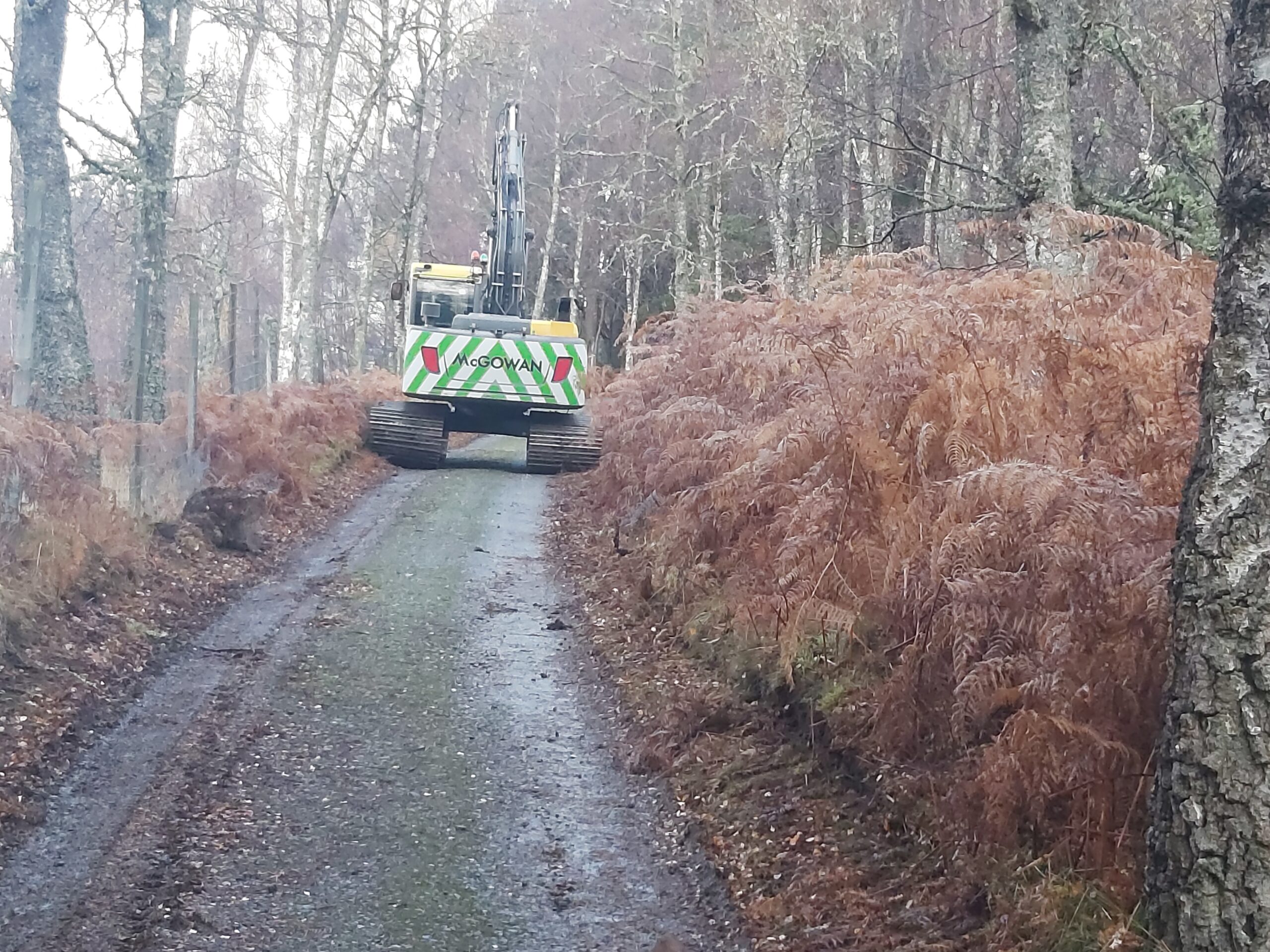
Following my most recent post on BrewDog’s Lost Forest (see here), I was sent some photos showing the impact of diggers on and around the Burma Rd which crosses from Strathspey over to the River Dulnain. The first clearly illustrates one aspect of the problem, some of the machines that have been used on the hill are wider than the road.
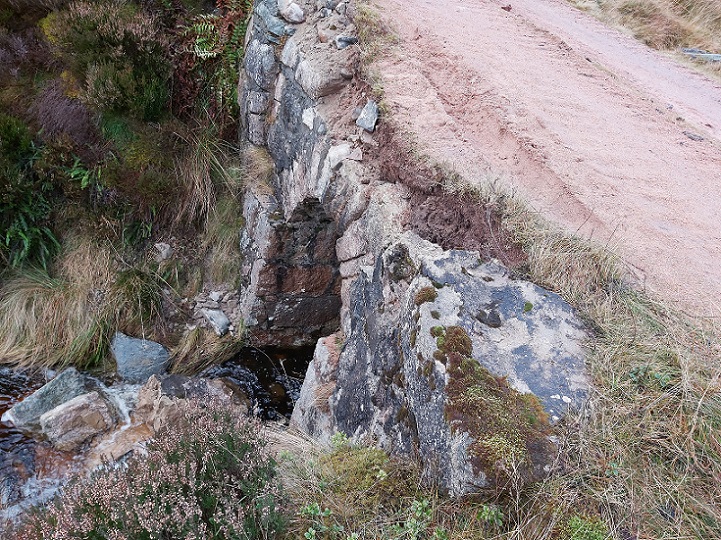
Higher up, at c500m, caterpillar tracks from an oversize vehicle have destroyed the edge of an attractive old bridge. Recent work on the Lost Forest has involved both ground preparation for tree planting and peatbog restoration. Due to a lack of transparency on the part of the public authorities which appear to be funding most of this work, Scottish Foresty and NatureScot, there is NO publicly available paper trail which might help establish which the projects – or maybe it was both? – have been using oversize vehicles on the hill and might be responsible for this damage.
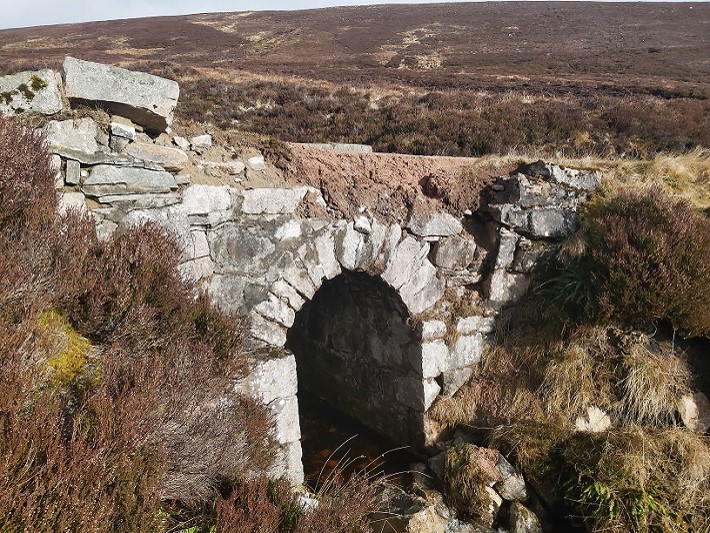
In 2021. in a welcome move to improve transparency, the Scottish Government required Peatbog Restoration schemes to be notified to the local planning authority. Three for the Lost Forest at Kinrara were notified to Highland Council, although only the location of one was given. These were granted prior approval without any specific conditions but in accordance with the “particulars submitted in the prior notification”. Unfortunately, whatever those particulars were they have now been removed from Highland Planning Portal (see here). It is not possible to tell therefore if those particulars contained details about the size of vehicles to be used or of contractors’ liabilities to repair any damage caused.
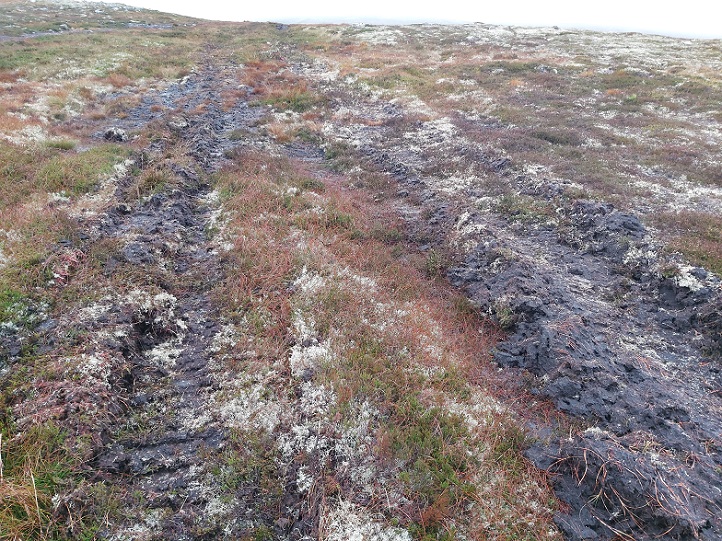
These vehicles are not damaging roads and bridges, they are damaging the wider landscape, the natural environment and exposing peat to the atmosphere where it breaks down releasing carbon. This undermines the carbon off-setting rationale which has been used to justify Scotland pouring large sums of public money into forest planting and peatbog restoration.
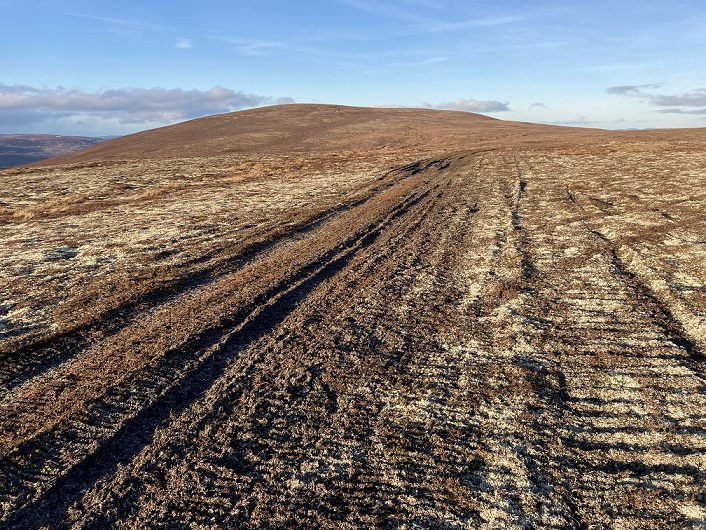
Lichen heath is a fragile habitat that does not tolerate being driven over. Lichens are also rich in carbon which they absorb from the atmosphere and convert in carbohydrates, hence why reindeer can survive on the them. How many years will it take BrewDog’s Lost Forest to recover from this carbon vandalism?
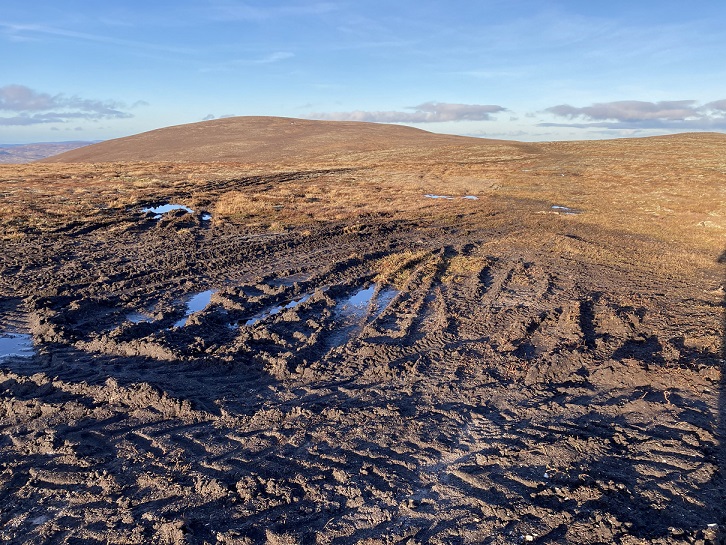
Do BrewDog know what is being in their name? If not, why not? What have the consultants who are employed to plan the forest planting and peatbog restoration done to prevent this? (The damage on the top of the hill appears most likely to have been caused by the peatbog restoration scheme). What about the funders, Scottish Forestry and NatureScot, what are they doing to ensure damage by vehicles, such as that featured here, is prevented?
If the work to create a new “Lost Forest” had been funded privately by beer drinkers and not the general public, damage such as this would warrant both tree planting and peatbog restoration schemes being brought fully into the planning system. But given that most of this work appears to have been publicly funded through Scottish Forestry and NatureScot, the Scottish Government should require both agencies to impose conditions on the use of vehicles in carbon off-setting projects as a matter of urgency.
“…some of the machines that have been used on the hill are wider than the road.”
And they probably exceed the weight limit for the bridge they have damaged. Still, it’s only an old bridge eh Brewdog?
Speculation without knowledge.
So do you know what damaged the bridge if not an oversized digger? If so, I would be very interested to hear. I have not published your other comment, different email name, same email number, but will be happy to do so if you can explain the cause of the damage.
never underestimate the capacity of politicians to ignore the ‘bleedin obvious’
This type of damage is an inevitable consequence of the way in which the Scottish Government is funding peatland restoration and forestry in upland areas. BrewDog’s activities on Kinrara are a perfect demonstration of all that is wrong with existing government policy and its associated financial incentives. Across Scotland £millions of public money are being wasted, every year, on these schemes. Instead the top priority should be a prohibition on muirburn, effective control of red deer populations, blocking of all moorland drains and an end to the massive deer fences now marching across our hills. A new approach is needed to secure landscape scale ecological restoration of grasslands, moorland and woodland, with their associated moss and lichen communities, to capture carbon, protect biodiversity and reduce downstream flooding. It is time for BrewDog to change tack and demonstrate they are part of the solution, not the heart of the problem.
Spot on Dave..
Oh! Dear. It’s the 2-tier justice system again. If anyone else came near to doing anything like that there would be hell’s bells to pay. They’d all be out with the hounds to hunt down the riff-raff from the Central Belt. But because it’s the “Double Standards Crew” they get the all clear. What a mess. The science on climate change has been there for over 40 years now. I was onto it early because of the fisheries. The response has been a cross between a soap opera and the rush for “the new gold.” It’s a total joke. We’ve got Green Nazis out to “Kill the Russians.” The only guy who’s making any sense on international affairs in the West is Trump. They’ll kill him if he gets anywhere near the White House again. I’m waiting for the Tartan Gestapo to come through the door any minute now.
No doubt this will be the basis of another of James’ candid “biggest regrets in my life / PR disasters” and plastered every in 12 months.
Bud, you don’t know 0.1% of it. I’m just passing through here between war zones. I’ve been all over the NP since it was the Interim C/ttee 1998. I was over 10 years on the NP Fish and Fisheries Forum. If you have zero to say don’t say it. The rest of us are identifying problems that have to be solved. We are paying for this shambles.
Brewdog are already on record, saying – ‘….regrettably, some minor damage has occurred to bridges from diggers in transit as we prepare land for tree planting……….all bridges have been assessed and repair work costed’
I wonder if there’s some grant money they can apply for to fund the repairs?
Nick, have you had an opportunity to collect any thoughts on your flawed analysis from your last blog on brewdog ?
I will copy and paste here to save you the trouble of searching back.
Hi Nick, thanks for responding, you said……
‘I stand by my view that the main monies being invested in Kinrara are public grants. If you can find information that shows this analysis is wrong I would be delighted to see it/be made aware of it.’
I refer you to my previous comment, where I described to you that £556k and £186k of Brewdog money spent/invested in Kinrara were sums far in excess of the £183k of peat grant money that is documented, in the accounts over the same time period.
My understanding of the accounts for 20 & 21, is that based on the above numbers, Brewdog have ‘spent’ over four times more than what they have received/ were awarded in Grant money over these two years.
Looking at 22, your analysis is ‘wrong’, to use your words, because you’re basing it on your, so far, unsupported statement that ‘over a £1m has been paid out’ in ‘grants for fences’, in an accounting period where no one has any idea what Brewdog have spent for comparison, because those accounts won’t be published until later this year.
Even if Brewdog have been paid the £1m you say they have, I don’t see how you can possibly stand by your stated view that ‘the main monies being invested in Kinrara are public grants’, when that clearly wasn’t the case in the two years 20,21, and because none of us at present know what Brewdog spent in 22, to compare to any paid grant received in 22.
Any thoughts?
Hi Nathan, if you can provide the source of BrewDog’s quote that would be great. As for the £556 that is not money invested, its the Lost Forest’s net liabilities at the end of the year. It rather proves my point, if BrewDog was investing in the company, its balance sheet would not be negative. So, to return the challenge to yourself, perhaps you can point to what BrewDog actually invested in the Lost Forest in the year in question? Yes it will have financed the administrative expenses £170k, shown in the accounts, but after the deducting income of £26k the net loss of £144k has resulted in the liabilities of the company increasing from £412k to £556k. It is worth noting that some of those administrative expenses will have been linked to the sales of property, making staff as I understand it redundant etc so it is far from clear how much has been spent on conservation. But whatever the amount it is exceeded by the £183k the Lost Forest received for peatbog restoration so I stand by my analysis. The really important point, however, with which I would hope you would agree was that if there were fuller accounts what BrewDog was actually investing would be completely clear. Nick
No problem Nick, that quote comes from Brewdog’s website, in the forum section under Lost Forest.
Are you able to provide a source yet to support your previous statement ‘By taking those grants for fencing – we know over a £1m has been paid out so far’ ?
Again, in your reply above, you have demonstrated, as I and others has previously pointed out that you are misinterpreting the accounts, but you continue to choose to do so.
On that basis I don’t think it would matter what level of accounts information Brewdog published.
Hi Nathan, It seems you have to be a shareholder to access the forum………………..I guess you are and that is maybe your interest in this? You have not replied to my explanation of why the £556k net liabilities in the accounts does not show investment by BrewDog as you claimed or my point that this shows for the year in question BrewDog appear to have received more in public grant than they put into the Lost Forest. Various newspaper reports have quoted amounts between £1.1 and £1.2m as the amount awarded by Scottish Forestry for the Lost Forest Phase 1. Unfortunately Scottish Forestry is not at all transparent about what it awards private landowners so until the next accounts are out we will not know exactly how much has been achieved. Whatever you may think of my opinions, would you be in favour of greater transparency about what public grants are being awarded to private landowners? Nick
The argument over the gradual industrialization of the landscape has persisted for a 1/4 of a millenium in the UK. Unlike much of Europe where fences and field boundaries used in agriculture are unusual and in all cases more transient.
A famed poem written in the 18th century sums up the constant battle that has despoiled the British landscape, a battle that has raged on unabated between land owning commercial interests and the ‘subservient rights’ of a “common man”. This poem from the 18th century reads as a protest against the ‘Inclosure Acts’. The debate about this practice is never over.
They hang the man and flog the woman
Who steals the goose from off the common
Yet let the greater villain loose
That steals the common from the goose.
The law demands that we atone
When we take things we do not own
But leaves the lords and ladies fine
Who take things that are yours and mine.
The poor and wretched don’t escape
If they conspire the law to break
This must be so but they endure
Those who conspire to make the law.
The law locks up the man or woman
Who steals the goose from off the common
And geese will still a common lack
Till they go and steal it back.
When the last completely natural view across open land in Scotland has been reworked ( to ” save the planet”???? ha! ha!) and the final hillsides and quiet ancient glens all acquire some engineered development, will late 21st C people even remember that all this misguided, greedy mechanical sacrilege for profit was in fact totally avoidable?
Apologies Nick. I must have accidentally pressed the enter key more than once when adding this poem.
Likely it happened because you wrote that in paragraphs with spaces between. The Enclosures go back to the transition from feudalism to capitalism. Capitalism requires the fortification of exclusive private property rights in land, labour and capital. What property and property relations mean is the heart and soul of Marxism-Leninism-Maoism. There’s no “Stalinism.” He was an ML. Capitalism is a social system of production or cooperation that’s founded on difference or a contradiction. On the one hand the Sovereign State is founded on a universal “us or we or ours.” The common people all told. On the other hand, the economic logic of capitalism, that’s enshrined in law, provides for a deprivation. Only some of the people own and control the land, labour and capital. The ruling class….especially the upper echelons of the ruling class and the Gov. However, before people became aware capitalism existed thanks to Marx, liberal thought was informed by moral ideas about good and evil. They took the moral high ground and made “Evil Others” of the rest. They still do that in their lies and propaganda. It get’s confusing because the logic of capitalism is not moral at all. It’s about power. Might is right and a $ is a $ good or evil. Guess where Parkswatch is located on that account?
Sorry Nick, having to reply as a new comment.
Please call me Nat, not even my mother calls me Nathan, and it’s less likely to get you into bother as data controller.
Do you ask every Parkswatch subscriber to explain their ‘interest’, or indeed any other subscriber ?
I’ve fully explained to you in a previous comment exactly why an increase in liabilities is evidence of Brewdog’s continued investment in Kinrara, and that these sums are greater than the evidenced grants received.
I confirmed my understanding of the accounts with someone suitably qualified, you may wish to do the same.
As you are unable to reference a specific source to support your previous statement ‘By taking those grants for fencing – we know over a £1m has been paid out so far’, are you going to correct or withdraw the statement in your previous blog?
Yes, I believe there should be greater transparency in awards of public money from the respective grants bodies. This needs to be mandated by Government, but as I said in my previous comment, I don’t see the point placing the onus on recipients publishing more information than they are already required to by law.
I am very happy to call you Nat and apologies for using your full name from your email – though I do appreciate it when commenters use their full name. I have asked other commenters in the past about their interest as I think its good for transparency though sometimes readers also point this out as they did in the case of my earlier post on BrewDog’s accounts when they pointed out a journalist who had commented had connections with BrewDog. First thing I will correct, however, is the statement I made in a comment in response to yourself that over £1m has been PAID so far – I should have said “committed” and apologise for the error (which I did not make in the main post). Grants for capital items like fencing are only paid on completion and those for planting are phased. I have no reason to doubt the amounts quoted in the press but will now try and establish the exact details through an FOI.
I will set out the facts for the year till Dec 2021, as stated in the accounts for the Lost Forest, once more. BrewDog could have invested in the company in two ways. The first as I have previously explained is shown in the income statement. It shows administrative expenses of £170k, income of £26k and a net loss of £144k. Since there was only £85k in cash in the accounts at the start of the year it appears BrewDog must have funded part of this but even if they funded all £170k that is less than the £183 received in grants. While those administrative expenses included the wages of staff £61k which I am happy to accept could be classed as an investment in the land (eg they may have been reducing deer numbers) it is also likely to include other things, necessary for running a business, including the costs of selling off assets. The second way BrewDog could have invested is by adding to Tangible Fixed Assets. Note 6 to the accounts shows that BrewDog invested £186k in additions to land or buildings (ie not conservation work as such) but at the same time they disposed of £1231 in land and buildings, £16k in plant and equipment and £28k in vehicles which is now held as cash. It may be that BrewDog has subsequently spent this cash on conservation work but we won’t know till the next accounts are out. The accounts till December 2021 therefore do not contain anything that suggests BrewDog has invested in conservation (that does not mean they have done nothing right, muirburn on the estate has stopped, that is helping natural regeneration of trees).